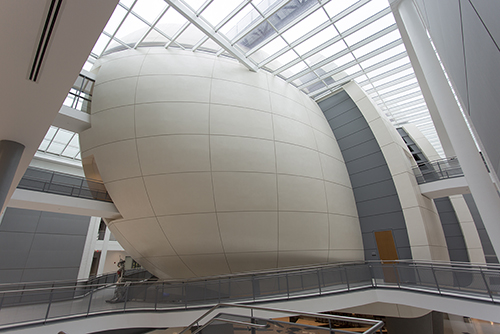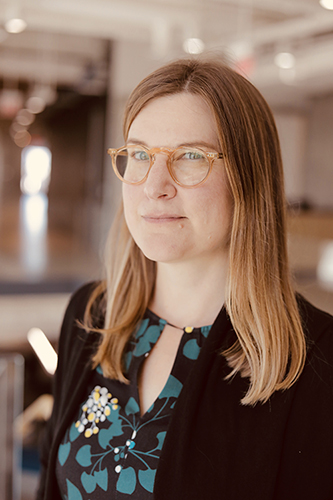Tuning the Technology and Acoustics at Duke Ellington School of the Arts

By Kirsten Nelson
It only takes a moment to realize that the Duke Ellington School of the Arts (DESA) is exceptional. Music, performance and visual arts emanates from everywhere within this Washington, DC high school, which was founded by passionate supporters and practitioners of the arts in 1974. From the start, students here have doubled down on their future careers, attending a rigorous academic program half the school day and then concentrating on the arts through the afternoon and often well into the night.
This is a school for dedicated individuals. They’ve auditioned, they’ve committed, and they’ve begun a lifelong path of contribution to the arts. Now, those accomplishments are reflected in the experience had by these exceptional students in a world-class facility built to provide a foundation for success. Following a complete renovation that expanded the historic building’s space by 100,000 square feet, there is a new palette of possibilities on offer — one on par with Duke Ellington School of the Arts Project affiliates the John F. Kennedy Center for the Performing Arts and George Washington University.
This high school is connected to the big-time, and now it shows. With a design powerfully named the “Arts Machine” by project architect cox graae + spack, the facility moves behind-the-scenes efforts to center stage, prompting enhanced collaboration among departments and providing new ways to invite the community to enjoy the dazzling creative output of a uniquely talented student body.
Central to the expanded facility is a show-stopping otherworldly orb floating in the center of the school’s four-story, 10,000-square-foot atrium. Affectionately nicknamed “The Egg,” it contains the 800-seat Duke Ellington Theatre, which serves as the cultural and technological hub for the school’s many rehearsal, performance, recording and educational spaces. Acoustic and performance systems for the entire project, along with IT, Wi-Fi and security networks for the facility, were designed by Polysonics. Washington Professional Systems handled the theater AV integration and CTSI implemented classroom technology.
As an inspiring icon for the whole project, The Egg presented interesting design challenges that created a ripple effect of technological choices throughout the rest of the school. Intentionally limited in size and capacity to create a more intimate feeling for performances and events, the theater would have to pack a lot of capability into comparatively little real estate. In a given day, the venue might be used for lectures or a quiet space for academic testing, and then have to turn around immediately to provide performance space for choral, orchestral or theatrical productions.
Such a range of needs made the design project a fun challenge for Polysonics, which has a legacy with the school. Decades ago, the firm’s President and COO, Gordon Jacobs, designed the sound reinforcement system (donated by Dr. Sidney Harman, no less) for the school’s previous theater. As a sign of both how successful that system was and how much the school may have needed some modernization, that system was still in use up until the venue was torn down in the recent all-encompassing renovation.
 Humbled by the honor of designing the “world-class performing arts facility” envisioned by late DESA co-founder Peggy Cooper Cafritz, who before her recent passing was a major force in fundraising for the renovation, Jacobs and the Polysonics team set to work.
Humbled by the honor of designing the “world-class performing arts facility” envisioned by late DESA co-founder Peggy Cooper Cafritz, who before her recent passing was a major force in fundraising for the renovation, Jacobs and the Polysonics team set to work.
First came The Egg. To make the room work from a technological and mechanical standpoint, Polysonics worked closely with theater design consultant Fisher Dachs throughout the process. The challenge was to accommodate an endless array of applications and still provide an acoustic and sound reinforcement scenario that wouldn’t overdrive the room when nearly 200 students took the stage for performances with the full orchestra and choir. An additional goal was to select professional-level equipment that would serve as a valuable training tool for students who would soon take up technical roles in venues across the country after graduation.
The relatively diminutive size of the room was a challenge, with just 800 seats and limited height (and therefore volume) in the space. After initially investigating various room treatment options, the decision was made to use an acoustic lift system, specifically the Meyer Sound Constellation, to electronically provide more or less reverberance according to event needs.
With the versatile centerpiece for the school’s performance needs met, then came the necessary extensions to allow for its vast body of prolific artists to perform. “Because we had limited space in the main theater, we looked to all the other rooms we could use, including the black box theater, two large rehearsal spaces and several medium-sized and smaller rehearsal spaces, and we wanted to link all rooms together,” Jacobs explains. So, in overflow scenarios, such as when a full 120-musician orchestra is required for a show, rooms can be linked to provide the full sound, even if the theater’s orchestra pit couldn’t possibly accommodate that many people.
That connection between rooms, provided by a Dante network, also encompasses the recording studio, enabling the use of any major room as a recording platform. And of course, there’s a broadcast feed to complete the world-class performance venue ideal.
If that seems like a lot of performance spaces to have operating at one time, consider the fact that during an average school day there are even more live rooms generating sound. Somehow the many rehearsal spaces, art studios, piano labs, percussion labs and countless other classrooms had to function simultaneously without sonic overlap.
“Next to the main orchestra room is the jazz room, and next to that is drum lab. They’re all stacked up,” Jacobs describes. “It forced us to have to do a lot of things at a much higher level with acoustic treatment.” That meant higher STC walls and floating floors, and their attendant construction challenges, but it all worked out in the end.
The results have garnered much praise, including a mention from Dave Chappelle on an episode of Jerry Seinfeld’s Comedians in Cars Getting Coffee. When a major celebrity specifically mentions the acoustics and PA, that’s a pretty nice moment.
But according to Jacobs, any moment walking the school’s halls is an inspiring moment, particularly as there are performance spaces set up in many places beyond the classrooms and rehearsal studios. “The students, they live this stuff,” he says. “The urge to perform is huge —they perform and play music and share their art work every chance they get. The school wanted to support that passion, so everywhere you go, there are performance spaces with pianos and PA setups available for impromptu performances.”
That connection between a desire to perform and the tools for sharing art with audiences is woven throughout the new DESA campus. The experience is constant. When class is in session, when a production is in the works or when these youthful artists just want to express some creative energy, the capabilities are there on a level that will prepare them for professions in their chosen creative fields. Based on the number of celebrated artists and performers who support DESA and bring their talents to its stages, it seems these students already have an audience with the finest practitioners. Now they just have to get on stage and make it happen.






